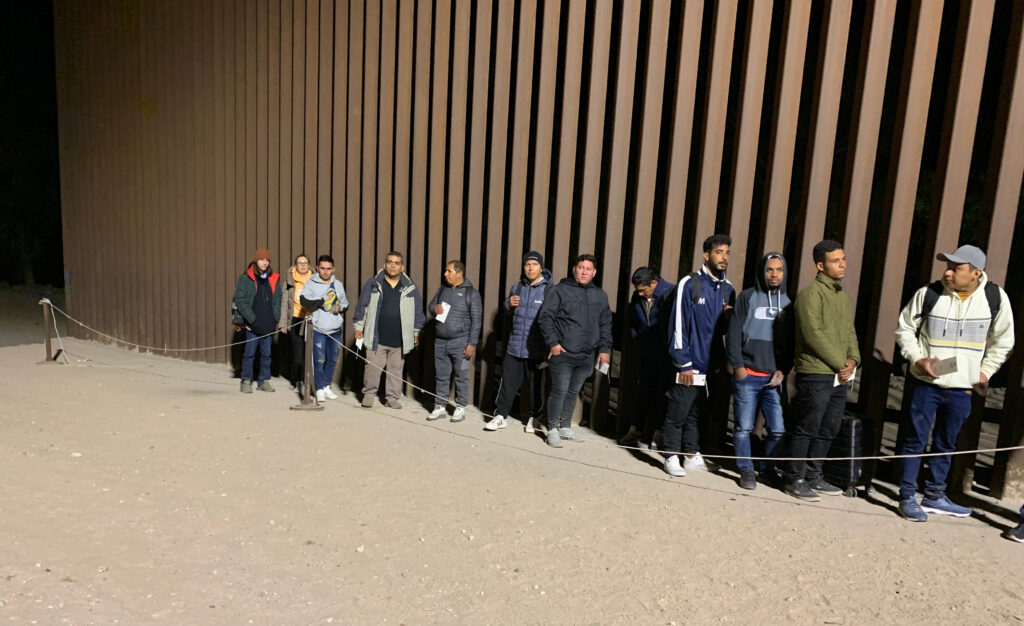I Couldn’t Believe What I Saw At Biden’s Lawless Open Border
The Mayorkas Migration Machine has channeled the immigration chaos at the U.S.-Mexico border in Arizona into a frighteningly mechanized and sanitized, though still lawless, system.
That is what I learned from visiting the U.S.-Mexico border in Arizona, six months after I toured it in Texas. President Joe Biden has visited the southern border once during his 51 years in Washington.
At many places in Arizona, the border is simply wide open. People of unknown identity, from anywhere in the world, can simply walk up and come in. It is that easy.
We visited a gap in the border wall near the Morelos Dam. At about 20 yards wide, it was supposed to be a vehicle gate when finished, but the day he took office, Biden ordered workmen to set down their tools. Ever since, it has been one of the most popular places for foreigners to enter the U.S. illegally on foot.
The Colorado River is drained low here to provide for American cities and farms while still delivering water promised to Mexico. Illegal entrants do not need to swim, and Mexican authorities have built a causeway to spare them from getting their shoes wet.
We visited the gap during the day and again at 3:00 a.m. During the day, we saw signs of mass migration. To hide the evidence from the American public, activist organizations regularly clean up the trash left behind by illegal immigrants. Still, some traces remained.
I walked through the sand and gleaned coins from Mexico — to be expected — but also from Peru and the Republic of Georgia. I picked up a passport from Cuba, debit cards from Mexico and Turkey, several Peruvian national identity cards, and a Mexican refugee card belonging to an Ecuadorian.
My favorite find was a Polish bank card belonging to a Gurpreet Singh. That is a Sikh name, meaning this man likely left his home in India’s Punjab, went to Poland for a while, perhaps claiming refugee status, and completed his journey to the United States via Biden’s open border.
At 3:00 a.m., we saw more than 100 people walking and running around the wall to join a long line to be “processed.” They all patiently waited for Border Patrol to take their photo, starting the process that will in most cases end with release into the U.S. interior a few days later.
Amazingly, they handed over their luggage to Border Patrol officers and collected a “Department of Homeland Security, Customs and Border Protection Baggage Check” tag so they could collect it later. Perhaps with a DHS credit card, they can check the first bag for free?
It was a linear Tower of Babel. We saw and spoke to people from Cameroon, China, Cuba, the Dominican Republic, Ecuador, Georgia, India, and Russia. I have seen poverty all over the world, and I know what it looks like. This was not it. The people in line, cold but cheerful, were just looking for work and opportunity. Some told us that themselves when I asked them in my rusty Hindi and Spanish.

As a former consular officer who has interviewed thousands of visa applicants, it was surreal to see the same aspiring economic immigrants, whom I met in embassies overseas, now lining up for easier admission into the U.S.
Here’s the difference. When consular officers interview applicants abroad, we assess their intent and the likelihood that they will obey their visas. The biggest visa condition is that they return home after their temporary visit. See Disneyworld and hit Miami Beach; go home. See a Yankees game and the Statue of Liberty; go home.
Applicants for permanent (immigrant) visas have to show a local police clearance certificate. In many countries, it is not worth much, but it is better than nothing. Applicants for tourist visas do not have to show anything at all, though a few times I have had local staff recognize an applicant from the newspapers as having a criminal record.
The people now showing up at the border outside ports of entry do not have to prove anything. They give DHS agents whatever name they want — no evidence required.
Immigration authorities do not bother to pick up their discarded documents in case they do not match what the illegal migrants later claim about themselves. Yet their claims will determine whether they obtain the right to live and work in the United States — probably forever. No one checks their foreign criminal history or could if they wanted to.
What are the odds that some have crimes to hide? Based on per-country estimates, a ballpark assessment suggests we are letting in dozens of thieves, a few murderers and rapists, and the occasional suspected terrorist every month, along with the average Joes. We will find out sooner or later, as criminals tend to re-offend.
But the real bad apples simply enter without any inspection at all. The authorities call them “gotaways.”
After Yuma, we rode along with a Pinal County, Arizona police anti-smuggling officer in an area a few hours to the east. He showed us many spots where smugglers hide out with drugs and illegal migrants, waiting for their ride after trekking through the desert from the border.
They discard piles of carpet slippers (to hide footprints), backpacks, and plastic water jugs, thousands of which litter the fragile desert landscape in another sign we have lost control.
Until DHS detains and holds most illegal entrants into the U.S. (as required by U.S. immigration law), and that message gets out, this lawless, corrupt farce at the southern border will play out every day.
A former State Department official, Simon Hankinson is a senior research fellow in The Heritage Foundation’s Davis Institute for National Security and Foreign Affairs.





Comments are closed.